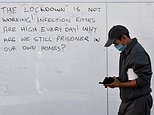Sydney’s south-west has Australia’s lowest Covid vaccination rate with resident fed up with lockdown
‘The lockdown is not working!’ Pictures from inside Covid ground zero show millions at the end of their tether with Australia’s most draconian restrictions – as data shows Sydney’s southwest have state’s LOWEST vaccination rate
- Sydney’s south-west is at boiling point with lockdown now in the fifth week with Defence Force on the streets
- Just 14.6 per cent of residents in these suburbs of Australia’s biggest city were fully vaccinated on August 1
- This was the worst in New South Wales and by far Australia’s lowest metropolitan Covid immunisation rate
- That was well below the national average of 19.7 per cent for those who had received two Covid vaccinations
- On Sydney’s affluent North Shore, 26.9 per cent of people have had two doses of either AstraZeneca or Pfizer
- Even anti-vaxxer NSW far north coast talking in Byron Bay, Mullumbimby had 17.2 per cent fully vaccinated
Residents trapped inside Australia’s Covid ground zero are fed up with the toughest restrictions anywhere in the country.
Sydney’s south-west is the epicentre of the Delta outbreak, with pictures showing the frustration of only being allowed 5km from home and being forced to wear a face mask outside at all times as the Defence Force patrols the streets and police helicopters circle the skies.
In Cabramatta, a white board expressed the mental anguish of many with the words: ‘Lockdown is not working! Infection rates are high every day! Why are we still prisoner in our own homes?’
The Fairfield council area also has Australia’s highest number of coronavirus cases, with 952 recorded during the past four weeks in suburbs where three-quarters of people speak a language other than English at home.


In Cabramatta’s main mall, a white board expressed the mental anguish of many with the words: ‘Lockdown is not working! Infection rates are high every day! Why are we still prisoner in our own homes?’
The multicultural outer suburbs of Australia’s biggest city are continuing to account for the vast majority of the new daily numbers, with New South Wales on Tuesday recording 199 new locally-acquired cases with 50 of them infectious in the community.
Sydney’s south-west also have the state’s lowest vaccination rate with just 33.1 per cent of those aged 16 and over having received a first dose, compared with the national average of 41 per cent as of August 1.
The proportion of fully-vaccinated people stood at just 14.6 per cent compared with 19.7 per cent nationally making it by far Australia’s worst metropolitan immunisation rate, federal Department of Health data showed.
In the more affluent North Shore of Sydney, 51.9 per cent of people have received one dose of either AstraZeneca or Pfizer, with 26.9 per cent having had two jabs.


Sydney’s south-west is the epicentre of the Delta outbreak, with pictures showing the frustration of only being allowed 5km from home and being forced to wear a face mask outside at all times as the Defence Force (pictured in Fairfield) patrols the streets
Compared with south-west Sydney even the Richmond-Tweed area of northern NSW, covering the traditional anti-vaxxer hubs of Mullumbimby and Byron Bay, had a higher first dose vaccination rate of 39.7 per cent with 17.2 per cent fully vaccinated.
Sydney’s eastern suburbs, where the Delta outbreak began in June, had a higher-than-average first dose rate of 44.8 per cent with 23.9 per cent in the two-dose category.
People in Sydney’s south-west are also more likely to work in services jobs like taxi driving, ride sharing or construction site labouring, which means they can’t work from home.
In Fairfield, the worst affected council area, Vietnamese is most commonly-spoken language other than English, followed by Arabic.
With daily case numbers stubbornly remaining in the triple digits, residents of the Fairfield, Liverpool, Canterbury-Bankstown, Cumberland, Parramatta, Blacktown, Campbelltown and Georges River council zones are banned from leaving their local government area for work unless they are employed in health, aged care or critical services.


Sydney’s south-west (pictured is a woman in Fairfield) also have the state’s lowest vaccination rate with just 33.1 per cent of those aged 16 and over having received a first dose, compared with the national average of 41 per cent as of August 1
NSW Chief Health Officer Kerry Chant has stressed at media conferences how she grew up in Punchbowl, in the Canterbury-Bankstown area.
The Reserve Bank of Australia is now expecting national gross domestic product to shrink in the September quarter, marking the first three months of contraction since the Covid recession of 2020, as a result of the Sydney lockdowns.
‘The economic outlook for the coming months is uncertain and depends upon the evolution of the health situation and the containment measures,’ Governor Philip Lowe said.
‘The recent outbreaks of the virus are interrupting the recovery and GDP is expected to decline in the September quarter.’


With daily case numbers stubbornly remaining in the triple digits, residents of the Fairfield (pictured is a sign in Arabic and English), Liverpool, Canterbury-Bankstown, Cumberland, Parramatta, Blacktown, Campbelltown and Georges River council zones are banned from leaving their local government area for work unless they are employed in health, aged care or critical services


The Reserve Bank of Australia is now expecting national gross domestic product to shrink in the September quarter, marking the first three months of contraction since the Covid recession of 2020, as a result of the Sydney lockdowns (pictured is a woman wearing a face shield as she shops for string beans at Fairfield)
![]()


